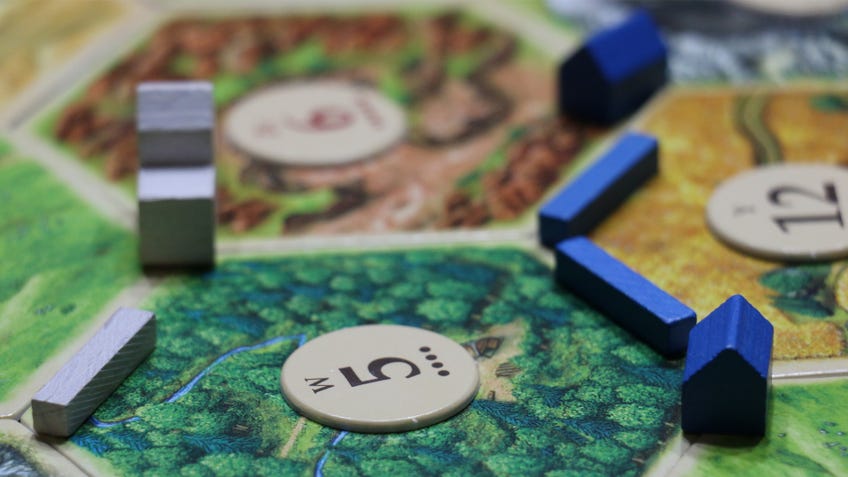12 best 1990s board games that are still worth playing today
Not noughtie, but nice.
The 1990s were a decade of cultural highs. In music, they brought us Nirvana, the Wu-Tang Clan and the Spice Girls. On cinema screens, we were gifted Babe, Starship Troopers and The Nightmare Before Christmas. Small screens were just as blessed, with TV shows including Fresh Prince, Twin Peaks and the golden age of The Simpsons.
It was a similarly fruitful time over on the tabletop. Several of the best board games from the ‘90s have become bona fide modern classics that have endured for 30 years, including tabletop releases that continue to be the most influential names in the hobby. Some are now having resurgences thanks to new films in the Jumanji series, and constant new Pokémon apps and games!
Best 90s board games
- The Settlers of Catan
- Magic: The Gathering
- Cranium
- Twilight Imperium
- Atmosfear
- El Grande
- Pokémon Trading Card Game
- Tigris & Euphrates
- Space Crusade
- Modern Art
- Netrunner
- Tichu
From the birth of trading card games with MTG’s release in 1993 to the mainstream breakthrough of Eurogames - board games traditionally focused on non-luck-based strategy over player interaction and theme - following Catan’s win of Germany’s prestigious Game of the Year prize, the Spiel des Jahres, in 1995, the nineties were maybe the most influential period for tabletop gaming yet.
While a number of tabletop games released before the millennium have since faded into the annals of analogue gaming, the greatest ‘90s board games have gone on to see numerous new editions, spin-offs and even inspired some of the best board games of the last few years. Whether you plan to take a trip down memory lane by revisiting some childhood favourites or are looking to experience some classics for the first time, here are the best board games released in the 1990s.
1. The Settlers of Catan
One of the most influential board games of all time
Year released: 1995

Before it become known as just Catan, The Settlers of Catan was a revelation for board games. Klaus Teuber’s game of collecting resources, trading goods and building settlements and roads across the fictional island marked the breakthrough of so-called ‘Eurogames’ into the mainstream - something that continues to be felt in the current golden age of board gaming’s popularity.
Distinctive for its blend of luck (dice rolls and card draws), social interaction as players trade goods and wrestle for territory, and variety as the island’s modular hexes are rearranged each game, Catan was unlike anything else on the tabletop when it released in the mid-nineties. Since then, it’s gone on to become a true classic, the closest modern counterpart to near century-old household names such as Monopoly, Scrabble and Cluedo in terms of sheer popularity, influence and recognition.
As well as shifting over 30 million copies of the original, it’s been joined by multiple expansions, spin-offs and digital versions, as well as an upcoming movie adaptation - no doubt helped by its popularity among celebrities including Frozen star Kristen Bell and pop star Carly Rae Jepsen, who have revealed their fondness for the board game on social media.
Whether you knew it as Settlers or came to it first as Catan, there’s no doubt that Catan remains one of the best board games released in the ‘90s - and an-all time masterpiece.
Buy Catan on Amazon US and Amazon UK.
2. Magic: The Gathering
The first trading card game - and still the best
Year released: 1993
It’s hard today to imagine a world without trading card games. Whether you’re tearing open physical booster packs or clicking on loot boxes in digital card games or other video games, the thrill of discovering what lies inside a sealed pack hasn’t faded in the almost 30 years since MTG first hit the tabletop.
The brainchild of Richard Garfield - who will make another appearance later in this list - Magic: The Gathering took the collectability of traditional trading cards and combined it with a taut, intense head-to-head battle between two players’ duelling mages.
The simple rules at MTG’s foundation - draw a card into your hand each turn, then spend mana to play creatures and spells to whittle your opponent down to zero life first - allows its cards to introduce endless gameplay variations through keywords and unique abilities. Its this unlimited potential that has kept Magic: The Gathering fresh for nearly three decades, with millions of players experimenting with each set’s new cards in inventive deck builds and the game’s distinctive formats.
MTG remains one of the best games of the ‘90s due to the strength of its gameplay and engrossing multiverse, but it’s also arguably the most influential tabletop game of the decade - and of all time. Look no further than the many trading card games that followed in its wake - including spin-offs that thrived in their own right and have similarly survived to today, such as the Pokémon TCG and Yu-Gi-Oh! - and the influence of MTG on games both on and off the tabletop. Not to mention the game’s own success, which now spans dozens of expansions, a successful tournament scene, video game adaptations, board game spin-offs, novels, an upcoming Netflix series and supplements for Dungeons & Dragons 5E. When it comes to massive tabletop games, there are few bigger.
Buy Magic: The Gathering - Core Set 2021 on Amazon US and Amazon UK.
3. Cranium
An all-in-one trivia game that brings together smarts with the arts
Year released: 1998
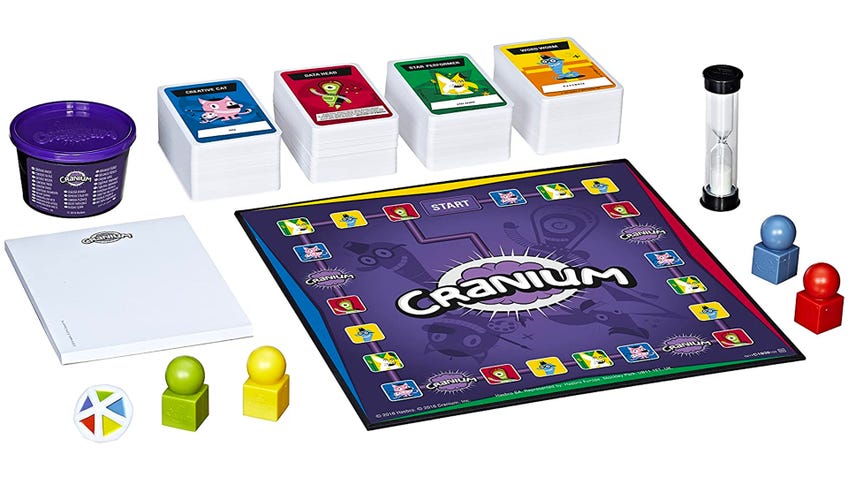
The best trivia games do more than just test your ability to recall knowledge. Cranium isn’t the most original board game ever made, but it combines elements from a number of proven hits to offer something that goes beyond just another quiz game.
As well as answering questions in the style of Trivial Pursuit, Cranium adds the drawing of Pictionary and clay-sculpting of Rapidough, plus Scrabble-style word puzzles and a touch of charades. On your turn, you could be guessing what song your teammate is whistling, what object they’re sculpting out of clay with their eyes closed or decrypting a scrambled word.
All of this is wrapped up in a colourful cartoon presentation that feels more engaging than your average family classic. While not influential by itself - instead the result of borrowing from other influential games - together Cranium is greater than the sum of its parts, offering one of the best board games of the ‘90s for families and players looking for something a little lighter. Just be aware that you might need to find some slightly fresher dough if you pick up an original copy.
Buy Cranium on Amazon US and Amazon UK.
4. Twilight Imperium
A sci-fi strategy classic that is epic in every sense of the word
Year released: 1997
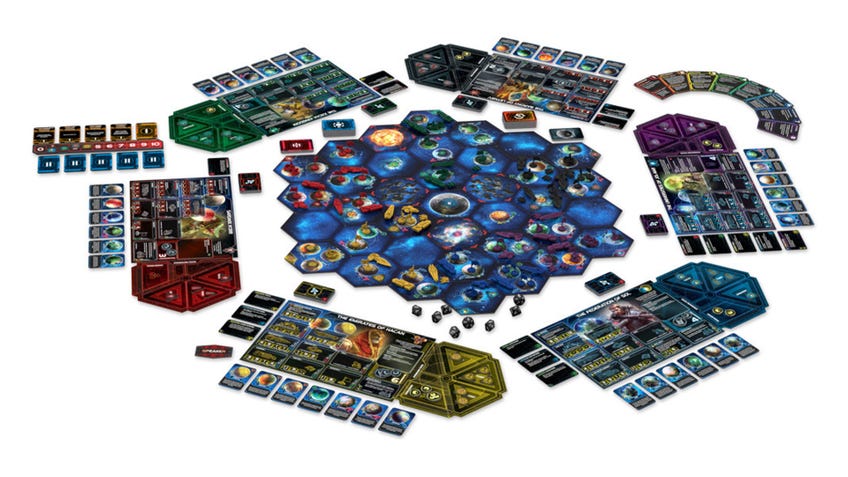
Space is big. Really big. So it makes sense that any board game set in space worth its salt should be equally massive. Enter Twilight Imperium: a humongous sci-fi strategy game that made its debut in 1997 with the impact of a meteor crashing to earth.
Designed by Christian T. Petersen, who released it through his then-brand new publisher Fantasy Flight Games - yes, that Fantasy Flight Games - Twilight Imperium was board gaming’s answer to the expansive universes of Star Wars and Star Trek. Set in an original galaxy populated by lion people, underwater aliens and various other inhabitants, each of which had their own strengths and weaknesses, Twilight Imperium was a sweeping game of conflict, trade and diplomacy that could stretch out over multiple handfuls of hours.
Every hour is worth it, though, with players engaging on multiple levels with the expansive solar system made up of hex-tile planets. You can wage a military war with fleets of spaceships, pursue domination via control of precious resources or even chase a political victory by swaying the galaxy to your whim by enacting laws during a voting phase. The unique abilities of each faction make every game an exciting sandbox of interaction between players, with
One of the greatest board games of the 1990s, Twilight Imperium has gone on to see multiple new editions that come in equally hefty boxes, with its latest fourth interaction one of the best board games released in recent years. There have also been several spin-offs inspired by its deep lore, including a remake of older sci-fi classic Dune titled Rex: Final Days of an Empire.
Buy Twilight Imperium on Amazon US and Amazon UK.
5. Atmosfear
An inventive horror board game played with a VHS tape
Year released: 1991

Before companion apps came companion cassettes. In the case of Australian horror board game Nightmare, a VHS cassette tape accompanied its boxed board and pieces, providing a spooky atmosphere (or rather Atmosfear, as the game was later renamed in Europe) to proceedings.
Guiding players through the scares was The Gatekeeper, the villainous game master who served as Atmosfear’s big bad. Players (or, as the Gatekeeper preferred to call them, “maggots”) needed to race around the board and collect six keys, before visiting the only slightly hilariously-titled Nightmare Square in the middle of the board to win.
They were racing against the tape itself, which lasted exactly 60 minutes - if the tape ran out, so did the players’ time, causing them to lose.
While Atmosfear’s theatrics might not seem quite as spooky today - and you’ll need to dig out a VHS player (or go hunting on the internet) to experience it as it was meant to be played - it’s still worth revisiting for the nostalgic factor. The gameplay was never revolutionary, but the idea of combining a video with a board game was ahead of its time - the idea would later evolve into DVD board games such as Scene It?, as well as the modern introduction of mobile and PC companion apps as a virtual guide for players.
Buy Atmosfear on Amazon UK.
6. El Grande
A ‘90s masterpiece from one of board gaming’s most celebrated creators
Year released: 1995
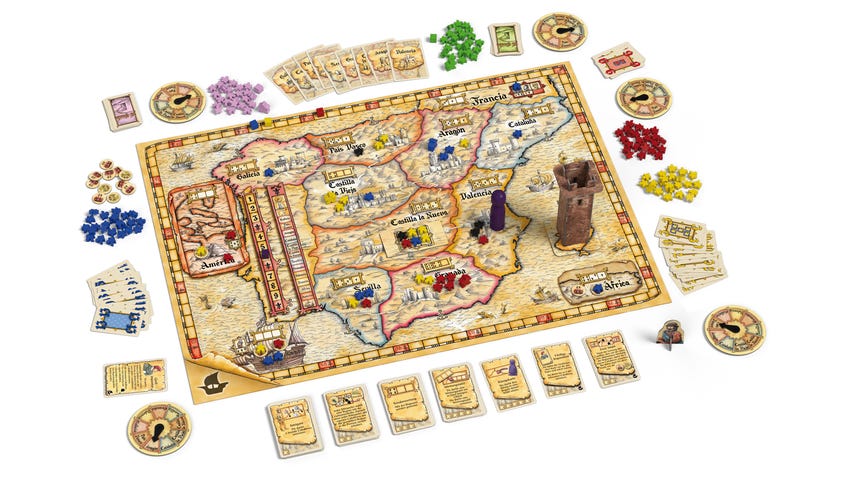
In the 1990s, few board game designers were at the peak of their powers as much as Wolfgang Kramer. The celebrated designer had already racked up two wins of Germany’s prestigious Game of the Year prize, the Spiel des Jahres, for Heimlich & Co. and Auf Achse during the previous decade. During the ‘90s, Kramer would win the Spiel des Jahres twice more, as well as earning various other accolades for other ‘90s board games that stand out as among the very best releases of the era, including the enduring card game 6 Nimmt!
Kramer’s first Spiel des Jahres win of the decade was for 1996’s El Grande, the result of his collaboration with fellow German designer Richard Ulrich, which we’ve picked out as the best of the best ‘90s board games from the talented creator.
Set in Spain during the Renaissance, El Grande sees players jostling for control of the country’s many regions. Players first play one of 13 cards to decide the order in which they take turns, as well as determining how many of their caballero knights - represented by dinky cubes on the board - they can draft from a central supply into their lord’s court.
Once the turn order is set, players take it in turns to choose one of five different action cards to deploy their caballeros to the map, as well as moving their king around the board to allow them to place caballeros in adjacent regions. Scoring is based on the differing value of each region and conducted every three rounds, with the game lasting nine rounds in total.
El Grande was the next game to win the Spiel des Jahres after The Settlers of Catan, and cemented the ‘90s as the decade for deeper strategic board games to thrive. Kramer would go on to win the Spiel des Jahres again in 1999 for Tikal, his first major collaboration with future Azul creator Michael Kiesling. Between El Grande, Tikal, 6 Nimmt! and more, Kramer was responsible for several of the best board games of the ‘90s - whichever you pick up, know you’re in for a time-proven, award-winning classic.
Buy El Grande on Amazon US and Amazon UK.
7. Pokémon Trading Card Game
The video game spin-off that became its own '90s phenomenon
Year released: 1998
Gotta catch ‘em all. It’s an endeavour that has lost little of its appeal since the Pokémon series first burst onto Game Boy screens nearly 30 years ago. Whether you started out holding B and down to net a Caterpie in Viridian Forest or came to the world of pocket monsters in the form of flicking Poke Balls on your phone screen in Pokémon Go, Pokémon remains an endlessly captivating collect-a-thon of filling out your Pokedex and creating the perfect team to prove you’re a Master Trainer.
Nowhere is that better realised than in the Pokémon card game, which launched in Japan in 1998, only a couple of years after Pokémon Red and Green first introduced pocket monsters to the world. Drawing directly from the gameplay of the video games, the Pokémon TCG allowed players to create their deck of Pokémon, items and abilities from booster packs of cards and sets in the style of Magic: The Gathering, before facing off against rival trainers in one-on-one battles.
Pokémon is as popular for players’ chance to collect all 151 (or many more, as later generations would make sure) pocket monsters as its turn-based battles, so a trading card game was the perfect fit. The cards introduced new variations of Pokémon and characters alongside familiar faces such as Pikachu, Charizard and Mewtwo, and also condensed the engrossing loop of the Pokémon games into a single match. Players would evolve their basic Pokémon into powerful later-stage forms, attaching energy cards to pull off devastating attacks and defeat their opponent’s party first.
Like Pokémon as a whole, the Pokémon card game has remained hugely popular since it was a staple of playgrounds in the 1990s. Helped by the explosion of Pokémon Go, the card game has made headlines with record-breaking sales of the rarest and most valuable Pokémon cards - many of which date from its earliest days. Meanwhile, the tournament scene has thrived, with professional players using the card game’s latest expansions to experiment with new gameplay mechanics and the latest generation of Pokémon from the video games.
Buy Pokémon TCG - Battle Academy on Amazon US and Amazon UK.
8. Tigris & Euphrates
A superb strategy game about the rise and fall of civilisations
Year released: 1997

There are few board game designers as prolific as Reiner Knizia, the mind behind Lost Cities, the Lord of the Rings co-op board game, The Quest for El Dorado and hundreds more board games from the last 30 years. Rarely has Knizia been more prolific and successful than during the 1990s, when he turned out a trilogy of beloved auction games - Modern Art, Medici and Ra - as well as a trio of acclaimed games involving tile-laying: Tigris & Euphrates, Samurai and through the Desert.
Of Knizia’s many brilliant ‘90s board games - as well as the rest of his vast oeuvre - Tigris & Euphrates is arguably his finest masterpiece. For many, it’s not just one of the best board games of the ‘90s, but one of the greatest strategy board games ever made.
Set between the titular rivers of the Tigris and Euphrates, the board game sees players growing their respective civilisations by placing square tiles on the board. These tiles are drawn from a bag and held in players’ ‘hands’ behind a screen, before they choose where to place them according to a number of rules. Each tile can be one of four colours - red, blue, green and black - representing a different element of the civilisation, from religion and farming to trade and settlements. Each player also has a leader tile for each of the four factions, which they can use to collect points as matching tiles are placed connected to the leader. If two civilisations are ever connected, conflict happens, with the winner determined by the most matching tiles on the board and those added from each player’s hand.
As with many Knizia games, Tigris & Euphrates also features a unique scoring twist. In this case, it’s the fact that each player’s lowest-scoring individual colour is their final score. This means that keeping your civilisation balanced is crucial to winning.
Since its release, Tigris & Euphrates has been regarded as one of the very best board games to emerge during the ‘90s, and the jewel in its decorated designer’s crown. It’s also seen a card game spin-off and a spiritual successor in the form of Yellow & Yangtze, as well as several digital versions you can play on your phone and PC. Brain-burning and brutal, it’s stood the test of time as well as the civilisations on its board.
Tigris & Euphrates is currently out-of-print and therefore tough to find. The digital version of sequel Yellow & Yangtze can be found on iOS, Android and PC.
9. Space Crusade
HeroQuest comes to the Warhammer 40,000 universe
Year released: 1990
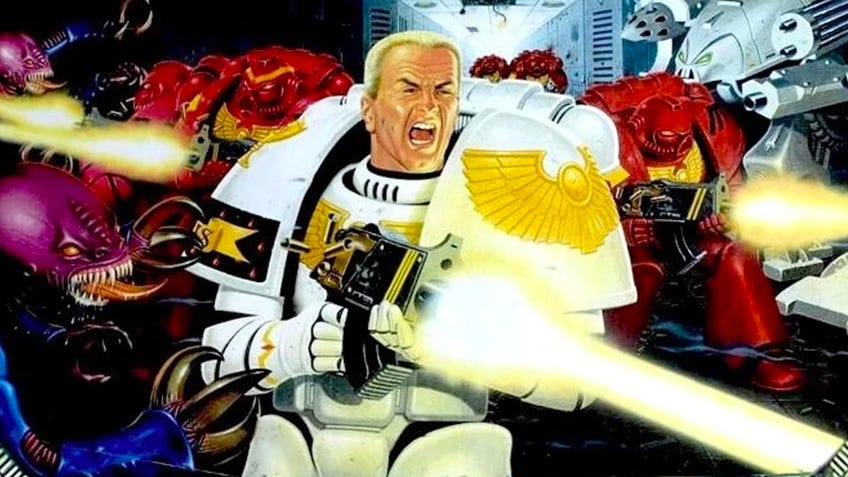
HeroQuest was one of the defining board games of the 1980s. The predecessor to modern dungeon-crawler games, it blended the GM-led adventuring and creativity of tabletop RPGs such as Dungeons & Dragons with the pick-up-and-play ease of board games. One player could create their own dungeons for the rest of the group to explore, with the party of fantasy staples battling monsters and collecting treasure as they went. It proved a hit, and would go on to see a sequel - Advanced HeroQuest - and inspire many other games, from Gloomhaven to Star Wars: Imperial Assault.
Among the earliest follow-ups to HeroQuest was 1990’s Space Crusade, released just one year after HeroQuest first hit tables. Transporting the action from the loosely Warhammer Fantasy-affiliated world of the original to the grimdark universe of Warhammer 40,000, Space Crusade saw players step into the heavy boots of Space Marine squads as they blasted their way through an assortment of 40K’s alien species.
Like HeroQuest, one player in Space Crusade controlled the enemies in an overlord-style role, taking control of Orks, Chaos and Tyranid Genestealers from the sci-fi miniatures game. The Space Marines, meanwhile, needed to try and complete their given missions, with a semi-cooperative aspect as the different player squads (each based on a familiar Space Marines chapter) attempted to be the most successful team of the bunch. Combat was fast and furious, resolved using dice, offering a simplified version of the strategic ranged and close-quarters warfare seen in Warhammer 40,000.
Space Crusade proved almost as popular as its fantasy sibling, going on to receive several expansions and its own Advanced Space Crusade sequel. While it’s since been out-of-print for a number of years, it’s one the most fondly-remembered board games from the ‘90s for many players - and still worth hunting down if you’re after an action-movie romp in the 41st millennium.
Space Crusade has been out-of-print for a number of years. Original copies can be found on auction sites such as eBay, although expect to potentially pay upwards of £200.
10. Modern Art
Buy and sell priceless paintings to make a pretty penny
Year released: 1992

As mentioned above, Reiner Knizia was one of the defining tabletop designers of the 1990s. While Tigris & Euphrates may be his magnum opus, it’s also a hefty undertaking that won’t suit every group. A slightly lighter board game that every player should own in their collection is his earlier knockout hit Modern Art.
In Modern Art, players are gallery owners looking to turn a tidy profit by selling and buying valuable paintings. These works of art are cards in their hand, one of which they must offer at auction each round.
Part of what makes Modern Art one of the - if not the - best auction games ever made is its inclusion of multiple different forms of auction, from open bidding and fixed-price sales to secret ‘sealed’ bids and rounds where every player has only one chance to present their highest offer. What’s more, the player who offers the card for sale can potentially outbid the other players to claim the painting for their own gallery, paying the money to the bank rather than receiving cash from the buyer.
The value of paintings isn’t fixed, but depends on the players’ own demand for cards sold that round - the more paintings by a certain artist that are sold, the more those paintings are worth, driving players to offer larger and larger sums for popular painters. After four rounds, the player with the most money - helped by their collection of valuable paintings - wins.
While Modern Art’s original release in 1992 divided opinion with its own artwork - some declaring it (slightly unfairly) one of the most unsightly games ever made - later editions have ensured that the game lives up to its title with the inclusion of real-life paintings by contemporary artists. Even if you don’t know your Picasso from your Kahlo, Modern Art is a fantastic ‘90s board game that’s truly a work of art.
Buy Modern Art on Amazon US.
11. Netrunner
The other legendary nineties card game from the creator of MTG
Year released: 1996

Netrunner is often overshadowed by its creator’s better-known collectible card game also released in the ‘90s: a little title by the name of Magic: The Gathering. Yet Richard Garfield’s later competitive two-player TCG is for many his true masterpiece, a sizzling cyberpunk showdown between hacker and mega-corporation with each side deploying their own unique tricks to emerge victorious.
Netrunner sees one player’s runner attempt to break through their megacorp opponent’s layers of security software - known as ICE - and access valuable data stored on servers. Meanwhile, the megacorp must beefen up their protection to force the runner to halt their hacks early before they can escape with their secrets.
Netrunner originally released in 1996 as a collectible card game similar to Magic: The Gathering, set in the dystopian future of tabletop RPG Cyberpunk 2020. While its original run under MTG publisher Wizards of the Coast was sadly short-lived - receiving only a couple of expansions before it was retired before the turn of the century - it saw a modern resurgence over a decade later in the form of living card game Android: Netrunner.
Android: Netrunner fared only slightly better before seeing its own cancellation in 2018, but lives on in the form of ambitious fan-made successor Project NISEI. Despite Netrunner’s premature end and limited success compared to Magic, it’s still regarded as one of the greatest card games ever made - and is easily one of the best board games the ‘90s produced.
Netrunner and Android: Netrunner are now both out-of-print, but Project NISEI can be downloaded from the organisation's website.
12. Tichu
Inspired by classics, this team card game is a race to ditch your hand first
Year released: 1991
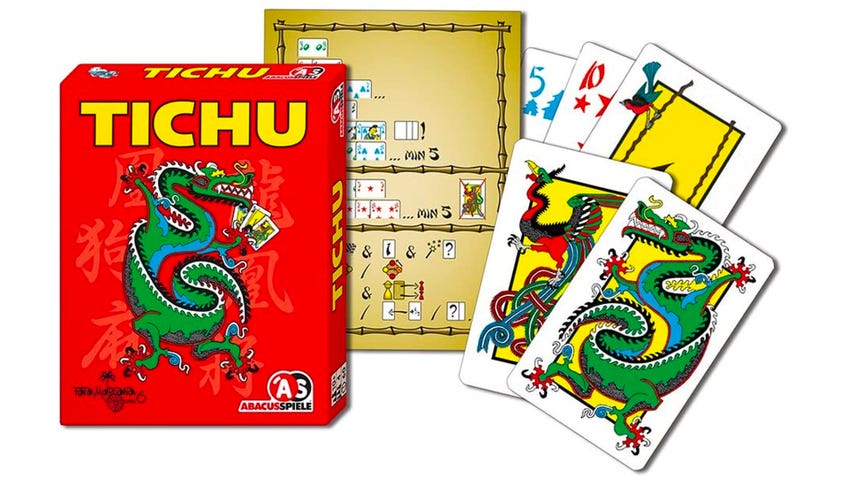
Influenced by traditional playing card games its Swiss designer, Urs Hostettler, was introduced to during a visit to China in 1988, Tichu combines elements of games including Bridge, Zhen Fen and Dou dizhu into a team trick-taking card game that’s become somewhat of a classic by itself.
Like the games that inspired it, Tichu uses a standard deck of 52 playing cards in four suits, plus four additional cards that represent a phoenix, dragon, dog and mahjong. Players must attempt to beat their opponents’ combination of cards to win each round, with each round needing to match the type of combination placed by the first player. These roughly follow poker hands, ranging from single high cards and pairs to straights of consecutive numbers and a full house. If a player can’t play, they must pass - three passes in a row ends the round.
The aim is to play as many cards from your hand as possible, as unplayed cards gain points for your opponents at the end of a round. The special cards introduce extra abilities, while non-poker combinations such as stairs - pairs of consecutive cards - and powerful bombs, a four of a kind or straight flush which cannot be beaten except by a bomb of greater value, add additional strategy.
Players can also declare that they will finish a round with an empty hand - known as a Tichu or Grand Tichu if announced before the player has seen all their cards, which are dealt in two phases - for bonus points, but face the risk of losing the same number of points if they fail.
Tichu draws from classic card games to create one of the best board games of the ‘90s - a tense, competitive showdown between players that feels as timeless as the games that inspired it.
Buy Tichu on Amazon UK.
